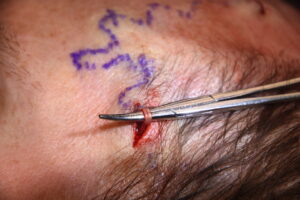One of the uncommon but not rare aesthetic forehead deformities is that of a prominent temporal artery. Usually appearing for no apparent reason the pattern of the anterior branch of the superficial temporal artery becomes partially or fully apparent as it crosses from the temporal hairline across the side of the forehead up into the scalp. It presents in a serpiginous pattern like a worm or snake. This appearance is exaggerated with anything that is known to cause arterial dilation or an accelerated heart rate.
Treatment of the prominent temporal artery is surgical. Unlike varicose veins in the lower extremities which are treated by extraction, temporal arteries must be treated by ligation. This is a technique whose objective is to eliminate their appearance by cutting off the blood flow into vessel. While the arterial flow may be forward (anterograde) moving from the ear towards the forehead, ligation must consider the high likelihood of back or retrograde flow. This occurs because arteries don’t have valves (like veins do) and are ultimately connected to the vessels from the other side of the head/face.


Aesthetic temporal artery ligation should not be confused with traditional medical artery ligation done for biopsies in the diagnosis of temporal arteritis. It requires more than one proximal ligation point and removal of a segment of the artery is not necessary.
Dr. Barry Eppley
Indianapolis, Indiana



